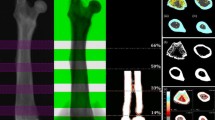Abstract
The accuracy, as well as the in vitro and in vivo precision of width and length measurements of human humerus and femur from dual energy X-ray absorptiometry (DXA) images, was investigated. The measurement was based on the bone area inside a specified region determined by the bone edge detection software of the scanner. The accuracy and in vitro precision studies were performed using a bone-simulating aluminum phantom embedded in different amounts of water. The in vivo precision was determined by measuring both limbs twice in 10 subjects (for humerus) and in 9 subjects (for femur). The accuracy was not significantly affected by the amount of water, and varied from 0.6 to 1.2%. Similarly, the in vitro precision varied from 0.4 to 0.6%. The average in vivo precision of the width measurement ranged from 0.4% (humeral and femoral midshaft) to 0.9% (proximal humerus), not depending on the size of the measured bone. The precision of the length measurement was 0.3% for the humerus and 3.7% for the femoral neck. In conclusion, the standard DXA technique provides a reliable measurement of the width and length in human humerus and femur in vivo, and thus may be useful in evaluating the properties of these bones in conjunction with the standard bone mineral measurements. Specifically, studies evaluating the effects of various types of mechanical loading (exercise) on bone may greatly benefit from this possibility because not only the bone mineral content and density but also the bone geometry change due to loading.
Similar content being viewed by others
References
Kellie SE (1992) Diagnostic and therapeutic technology assessment (DATTA): measurement of bone density with dual-energy X-ray absortiometry. JAMA 267:286–294
Chesnut CH III (1992) The imaging and quantitation of bone radiographic and scanning methodologies. In: Coe FL, Favus MJ (eds) Disorders of bone and mineral metabolism. Raven Press, New York, pp 443–454
Faulkner KG, Gluer C-C, Majumdar S, Lang P, Engelke K, Genant HK (1991) Noninvasive measurements of bone mass, structure, and strength: current methods and experimental techniques. AJR 157:1229–1237
Johnston CC Jr, Slemenda CW, Melton LJ (1991) Clinical use of bone densitometry. N Engl J Med 324:1105–1109
Sievänen H, Oja P, Vuori I (1992) Precision of dual-energy X-ray absortiometry in determining bone mineral density and content of various skeletal sites. J Nucl Med 33:1137–1142
Sievänen H, Kannus P, Oja P, Vuori I (1993) Precision of dual energy x-ray absortiometry in the upper extremities. Bone Miner 20:235–243
Dalen N, Hellström LG, Jacobson B (1976) Bone mineral content and mechanical strength of the femoral neck. Acta Orthop Scand 47:503–508
Hansson T, Roos B, Nachemson A (1980) The bone mineral content and ultimate compressive strength of lumbar vertebrae. Spine 5:46–55
Currey J (1984) The mechanical adaptations of bones. Princeton University Press, New Jersey, pp 3–157
Einhorn TA (1992) Bone strength: the bottom line. Calcif Tissue Int 51:333–339
Goldstein SA (1987) The mechanical properties of trabecular bone: dependence on anatomic location and function. J Biomech 20:1055–1061
Cowin SC (1983) The mechanical and stress adaptive properties of bone. Ann Biomed Eng 11:263–295
Whalen RT, Carter DR, Steele CR (1988)_Influence of physical activity on the regulation of bone density. J Biomech 21:825–837
Frost HM (1988) Vital biomechanics: proposed general concepts for skeletal adaptations to mechanical usage. Calcif Tissue Int 42:145–156
Frost HM (1993) Suggested fundamental concepts in skeletal physiology. Calcif Tissue Int 52:1–4
Phillips JR, Williams JF, Melick RA (1975) Prediction of the strength of the neck of the femur from its radiological appearance. Biomed Eng 10:367–372
Jurist JM, Foltz AS (1977) Human ulnar bending stiffness, mineral content, geometry and strength. J Biomech 10:455–459
Martin RB, Burr DB (1982) Non-invasive measurement of long bone cross-sectional moment of inertia by photon absortiometry. J Biomech 17:195–201
Steele CR, Zhou L-J, Guido D, Marcus R, Heinrichs WL, Cheema C (1988) Noninvasive determination of ulnar stiffness from mechanical response—in vivo comparison of stiffness and bone mineral content in humans. J Biomech Eng 110:87–96
Myburgh KH, Zhou L-J, Steele CR, Arnaud S, Marcus R (1992) In vivo assessment of forearm bone mass and ulnar bending stiffness in healthy men. J Bone Miner Res 7:1345–1350
Beck TJ, Ruff CB, Warden KE, Scott WW, Rao GU (1990) Predicting femoral neck strength from bone mineral data—a structural approach. Invest Radiol 25:6–18
Cleek T, Whalen R (1993) Bone geometry, structure and mineral distribution using DXA (abstract) 9th International Bone Densitometry Workshop. Calcif Tissue Int 52:154.
Faulkner KG, Gluer CC, Genant HK (1993) Hip axis length and bone mineral density as independent predictors of hip fracture: a prospective study (abstract) 9th International Bone Densitometry Workshop. Calcif Tissue Int 52:168
Zanchetta JR, Capozza RF, Sanchez TV, Feretti JL (1993) Correlation between noninvasively determined geometric and mechanical properties and BMC or BMD in the human femoral neck (abstract) 9th International Bone Densitometry Workshop. Calcif Tissue Int 52:169
Dalen N, Låftman P, Ohlsen H, Strömberg L (1985) The effect of athletic activity on the bone mass in human diaphyseal bone. Orthopedics 8:1139–1141
Author information
Authors and Affiliations
Rights and permissions
About this article
Cite this article
Sievänen, H., Kannus, P., Oja, P. et al. Dual energy X-ray absorptiometry is also an accurate and precise method to measure the dimensions of human long bones. Calcif Tissue Int 54, 101–105 (1994). https://doi.org/10.1007/BF00296059
Received:
Accepted:
Issue Date:
DOI: https://doi.org/10.1007/BF00296059




